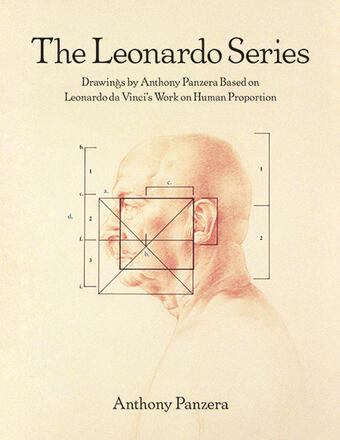
The Leonardo Series
Drawings by Anthony Panzera Based on Leonardo da Vinci's Work on Human Proportion
A one-to-one encounter with Leonardo da Vinci's work on human proportion.
Description
Over the past forty-six years, Anthony Panzera has worked with the human figure as the center of his artistic expression. The issue of human proportion and an understanding of anatomy are essential to drawing the figure convincingly and have been of paramount concern for all artists since the ancient Greeks. Many artists have attempted to codify human proportions, and not least among them is Leonardo da Vinci (1452–1519).
Leonardo was a genius among artists and thinkers, and his Notebooks dealt with innumerable subjects: the flight of birds, the flow of water, anatomy, human proportion, and many other subjects. The lack of an organic visual and textual study of Leonardo's drawings and commentaries on human proportion led Panzera to a critical investigation of the master's work on the subject, focusing on the observations in his Notebooks. This was a daunting exercise as his notes are scattered throughout many pages and are in no particular order. Some are simply scribbled notations in Leonardo's tiny hand, squeezed in among various other notes of sometimes unrelated material, while others are beautiful drawings combined with detailed text, such as the brilliant Vitruvian Man.
Initially, Panzera began collecting Leonardo's observations on human proportion and then creating drawings from life to test the validity of the observations. What began as a number of isolated drawings gradually evolved into a thirty-year project, culminating in a total conceptualization of a one-to-one encounter between Leonardo's words and drawings and Panzera's analyses and drawings.
Leonardo never did get to fulfill his promise to organize his work on human proportion. This book attempts to do just that. Panzera organizes Leonardo's work by the individual parts of the body and takes it one step further by analyzing and verifying the accuracy of Leonardo's observations. In order to create a comprehensible guide to Leonardo's systems of proportion, each page includes a reference to a specific Leonardo drawing and observation, which is then faced by a page with the corresponding drawing by Panzera, accurately drawn and measured from life. The illustrations, analytical text, accompanying chapters that place Leonardo's work in the history of proportion, and reproductions of Leonardo's pages and drawings provide a clear and basic understanding of Leonardo's systems of proportion for artists, students, academics, and others interested in delving into the brilliant, diverse, and complicated mind of the master.
Anthony Panzera is Professor Emeritus, Department of Art, Hunter College, City University of New York.
Reviews
"…[an] elegant collection of fine, sepia-toned studies of the human figure … The collection as a whole is a stunning work of art and an impeccable contribution to art historical scholarship, as remarkable in its union of art and science as Leonardo's own marriage of spirit and matter. Finely drawn in sanguine pencil, Panzera's figures impart a sense of ethereal beauty unto themselves." — Leonardo Reviews